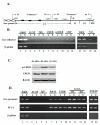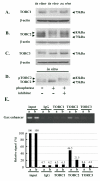Involvement of TORC2, a CREB co-activator, in the in vivo-specific transcriptional control of HTLV-1
- PMID: 19664292
- PMCID: PMC2734550
- DOI: 10.1186/1742-4690-6-73
Involvement of TORC2, a CREB co-activator, in the in vivo-specific transcriptional control of HTLV-1
Abstract
Background: Human T-cell leukemia virus type 1 (HTLV-1) causes adult T -cell leukemia (ATL) but the expression of HTLV-1 is strongly suppressed in the peripheral blood of infected people. However, such suppression, which may explain the long latency in the development of ATL, is readily reversible, and viral expression resumes quickly with ex vivo culture of infected T -cells. To investigate the mechanism of in vivo -specific transcriptional suppression, we established a mouse model in which mice were intraperitoneally administered syngeneic EL4 T -lymphoma cells transduced with a recombinant retrovirus expressing a GFP-Tax fusion protein, Gax, under the control of the HTLV-1 enhancer (EL4-Gax).
Results: Gax gene transcription was silenced in vivo but quickly up-regulated in ex vivo culture. Analysis of integrated Gax reporter gene demonstrated that neither CpG methylation of the promoter DNA nor histone modification was associated with the reversible suppression. ChIP-analysis of LTR under suppression revealed reduced promoter binding of TFIIB and Pol-II, but no change in the binding of CREB or CBP/p300 to the viral enhancer sequence. However, the expression of TORC2, a co-activator of CREB, decreased substantially in the EL4-Gax cells in vivo, and this returned to normal levels in ex vivo culture. The reduced expression of TORC2 was associated with translocation from the nucleus to the cytoplasm. A knock-down experiment with siRNA confirmed that TORC2 was the major functional protein of the three TORC-family proteins (TORC1, 2, 3) in EL4-Gax cells.
Conclusion: These results suggest that the TORC2 may play an important role in the in vivo -specific transcriptional control of HTLV-1. This study provides a new model for the reversible mechanism that suppresses HTLV-1 expression in vivo without the DNA methylation or hypoacetylated histones that is observed in the primary cells of most HTLV-1 -infected carriers and a substantial number of ATL cases.
Figures






References
Publication types
MeSH terms
Substances
LinkOut - more resources
Full Text Sources
Miscellaneous

